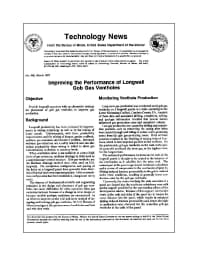Mining Publication: Technology News 448 - Improving the Performance of Longwall Gob Gas Ventholes
Original creation date: March 1995
Authors: WP Diamond
NIOSHTIC2 Number: 20023959
Pittsburgh, PA, U.S. Department of the Interior, Bureau of Mines, Technology News 448, 1995 Mar :1-2
Longwall productivity has been increased by improvements in mining technology as well as by the mining of larger panels. Unfortunately, with these productivity improvements and the mining of deeper, gassier coalbeds, methane gas emissions can become a problem. Increased methane gas emissions are a safety concern and can also reduce productivity when mining is halted to allow gas concentrations to decline to statutory levels. When ventilation alone is not sufficient to control high levels of gas emissions, methane drainage is often used as a supplementary control measure. Gob gas ventholes are the methane drainage method most often used on U.S. longwalls. The completion configuration and spacing of the holes on a longwall panel have generally been determined by trial-and-error experimentation. Once a completion configuration has been established, changes are rarely made. The absence of fundamental scientific and engineering principles in the design and placement of gob gas ventholes can cause difficulties for mine operators when gas emissions increase because of a change in mine design or because variable geologic conditions are encountered. In an effort to improve on the trial-and-error method of designing and locating gob gas ventholes, the U.S. Bureau of Mines investigated the performance of such holes and how and why they work.

NIOSHTIC2 Number: 20023959
Pittsburgh, PA, U.S. Department of the Interior, Bureau of Mines, Technology News 448, 1995 Mar :1-2
- A CART Technique to Adjust Production from Longwall Coal Operations under Ventilation Constraints
- Degasification System Selection for U.S. Longwall Mines Using an Expert Classification System
- Longwall Gob Degasification With Surface Ventilation Boreholes Above the Lower Kittanning Coalbed
- Methane Control by Isolation of a Major Coal Panel - Pittsburgh Coalbed
- Methane Emission Rate Studies in a Central Pennsylvania Mine
- Modeling and Prediction of Ventilation Methane Emissions of U.S. Longwall Mines Using Supervised Artificial Neural Networks
- Numerical Analysis of the Impact of Longwall Panel Width on Methane Emissions and Performance of Gob Gas Ventholes
- Probabilistic Modeling Using Bivariate Normal Distributions for Identification of Flow and Displacement Intervals in Longwall Overburden
- Technology News 465 - Method for Predicting Methane Emissions on Extended Longwall Faces
- Underground Gob Gas Drainage During Longwall Mining